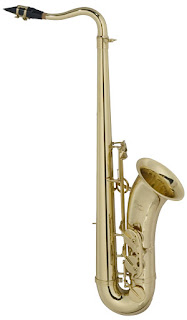Keyless Tenor
Coming Soon to the website! http://www.kdimusic.com/
The Rheuben Allen "Almost Keyless Saxophone" is a valuable learning tool for the serious student, who wants to extend the range of the saxophone and learn how to play in tune.
The most important reason to practice overtones is to learn how to play in tune correctly. It's a misconception that putting the mouthpiece in just the right spot on the neck will get the saxophone to play in tune. A lot of things go into it. Using the correct reed strength with the correct mouthpiece tip opening; making sure you are playing with enough air pressure; using the correct embouchure. However perhaps the most important aspect of playing in tune is being able to control your throat position.
Much like a singer, the saxophone player opens and closes their throat to fine tune the pitch of each note. Only this way will you truly be able to play in tune. Every day when you talk, your throat moves around constantly to help produce the sounds that create language. So you know how to open and close your throat already. However much like your heart beating, it's a muscle that we don't consciously control. The "Almost Keyless Saxophone" was designed to allow the player to focus on controlling the muscles in their throat through playing overtones.
Since the instrument has no keys higher than Low C#, when you blow into the "almost keyless saxophone" you get a Low C. Changing your throat position is the only way you will be able to get out any other note. The next note you should be able to trigger is the middle C. Then the G above that, then high C, E, G. With this high G you are now playing above the intended range of the saxophone. From there you can keep going and going. It takes a lot of practice, but it is possible to play 2 octaves above this high G. However the real world result is this...the next time you are playing a high C# and your saxophone is playing sharp (as is usually the case on most instruments), you can just open your throat to drop the pitch down slightly. You can do this because, the overtone exercises have given you full control of the throat muscles.
When I'm teaching a clinic, I usually have someone ask this, "But my band director told me to drop my jaw when I'm sharp, so why do I have to work on overtones?" Well dropping the jaw does lower the pitch. However what it is really doing is forcing you to open your throat. The problem is that dropping your jaw loosens your embouchure, thus changing your tone quality. True flexibility of the throat is the only way to play in tune. You will also see your tone improve dramatically by practicing the overtones. An open throat position will create a rich full sound that the saxophone was meant to have.
Nothing is more important than playing in tune with a good sound, however another and perhaps more popular reason for working with the "Almost Keyless Saxophone" is to extend the range of the saxophone. Most saxophones are designed to be played up to high F or F#. From the low Bb, that's only 2 and a half octaves of range. Most professional saxophone players can go much higher. A common misconception is that there are special "false" fingerings that will get the saxophone to play notes higher than their designed range. While it is true that these fingerings will help get those desired notes, it is the manipulation of the throat that does 90% of the work. The throat must be in the correct position to trigger these high notes. Working with overtones will give you that flexibility.
Since using Rheuben Allen's "Almost Keyless Saxophone" with my students, I have seen a vast improvement in their range and intonation. I have also found it to be a very effective lecture demonstration tool and it has become an integral part of any saxophone workshop I present. Whether you are a teacher or a student, I'm sure you will find it just as useful.
Dave Goldberg
Professional Saxophone Instructor and
Tritone Records Jazz Recording Artist



Comments
Post a Comment